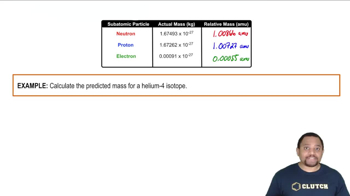Mass Defect definitions Flashcards
 Back
BackMass Defect definitions
1/15
Terms in this set (15)
- Mass DefectDifference between predicted mass of an isotope and its actual nuclear mass due to energy conversion.
- Predicted MassSum of the masses of all subatomic particles in an element before isotope formation.
- Nuclear MassActual mass of an isotope's nucleus, found on the periodic table as atomic mass.
- Subatomic ParticlesConstituents of an atom, including neutrons, protons, and electrons.
- NeutronSubatomic particle with a mass of 1.00866 amu, found in the nucleus.
- ProtonSubatomic particle with a mass of 1.00727 amu, found in the nucleus.
- ElectronSubatomic particle with a mass of 0.00055 amu, orbiting the nucleus.
- Atomic Mass UnitUnit of mass equal to 1.66 x 10^-27 kilograms, used for subatomic particles.
- First Law of ThermodynamicsPrinciple stating energy cannot be created or destroyed, only transformed.
- Energy ConversionProcess where mass lost during isotope formation is transformed into energy.
- E=mc^2Einstein's equation relating mass and energy, allowing conversion between the two.
- IsotopeVariant of an element with a specific number of neutrons and protons in the nucleus.
- Mass NumberTotal number of protons and neutrons in an atom's nucleus.
- Atomic MassMass of an atom, typically found on the periodic table, representing nuclear mass.
- Energy AbsorptionProcess where energy is used to break an isotope into its subatomic particles.



